Nicole schreibt...
Cuba 2009 |
 |
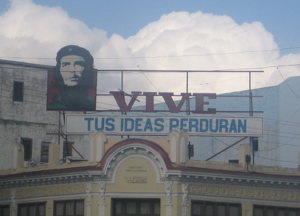 For a long long time I had simply believed the western tales of Cuba as some sort of dirt-poor horrible communist prison ruled by Fidel Castro with an iron fist and thus was never all that interested in visiting the island. But more recently I began to change my mind most of all the fact that I had to write some background information on Cuba for my new job and found out about the good sides of Cuban socialism for the first time free health care for everyone, the highest levels of literacy and secondary education in the Caribbean and a better standard of living than in some Eastern European countries, not to mention the Third World. Another influence was Tariq Ali’s (admittedly very left-wing) book Pirates of the Caribbean about the old (Fidel) and new (Hugo Chavez) left-wing governments in Latin America and while I dont fully agree with him, nor have I ever been a leftie, I did agree with him that Hugo Chavez is getting more bad press here than is justified and most people just believe what they are spoon-fed by their governments and the media without thinking for themselves. Which was something I so angrily critized when American and British friends gobbled up Bush and Blair’s propaganda for the Iraq War wholesale, so I didn't want to fall into the same trap.And now with Fidel Castro with one foot in the grave and a much more liberal and conciliation-seeking new US president Barack Obama, things between the two arch enemies could change soon and I decided to get a look at Cuba while it’s still this curious singular socialist paradise under the Caribbean sun before it gets swamped with US motel chains and junk food outlets. Though will it? Having read a couple of books on Cuba’s revolution, its causes and the more recent developments, I am not sure.
For a long long time I had simply believed the western tales of Cuba as some sort of dirt-poor horrible communist prison ruled by Fidel Castro with an iron fist and thus was never all that interested in visiting the island. But more recently I began to change my mind most of all the fact that I had to write some background information on Cuba for my new job and found out about the good sides of Cuban socialism for the first time free health care for everyone, the highest levels of literacy and secondary education in the Caribbean and a better standard of living than in some Eastern European countries, not to mention the Third World. Another influence was Tariq Ali’s (admittedly very left-wing) book Pirates of the Caribbean about the old (Fidel) and new (Hugo Chavez) left-wing governments in Latin America and while I dont fully agree with him, nor have I ever been a leftie, I did agree with him that Hugo Chavez is getting more bad press here than is justified and most people just believe what they are spoon-fed by their governments and the media without thinking for themselves. Which was something I so angrily critized when American and British friends gobbled up Bush and Blair’s propaganda for the Iraq War wholesale, so I didn't want to fall into the same trap.And now with Fidel Castro with one foot in the grave and a much more liberal and conciliation-seeking new US president Barack Obama, things between the two arch enemies could change soon and I decided to get a look at Cuba while it’s still this curious singular socialist paradise under the Caribbean sun before it gets swamped with US motel chains and junk food outlets. Though will it? Having read a couple of books on Cuba’s revolution, its causes and the more recent developments, I am not sure.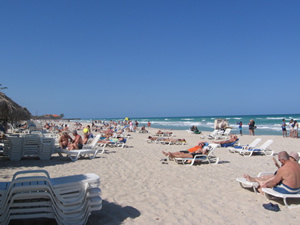 We had gone the easy way and booked a weeks package tour to Cubas most popular beach resort in Varadero, about 150 kilometres east of the capital Havana. Varadero was once a popular resort for the Americans who de facto ruled the islands economy before the revolution ousted them, then sank into a long slumber until Cuba badly needed new income after the fall of their big partner and helper, the Soviet Union and they followed the idea of other poor Caribbean nations to lure tourists to their beaches. While the Americans were missing for obvious reasons, I was surprised to find the resorts full of Canadians, especially of groups of college-age kids and families, with only few Europeans in sight. Upon arriving at our chosen hotel, the Arenas Blancas, we were told that it was overbooked and we had to spend the first two nights at another hotel of equal standard, the Playa d’Oro, which was fine with me. Since we got there in the late afternoon, the first full day was spend simply chilling on the beach and soaking up some much-needed sunshine after the longest, coldest, dullest winter I’ve seen in Germany for a long time. The second day was cut in half by the transfer back to the Arenas Blancas, but the travel operator apologized by way of arranging a late check-out on our last day without additional fees and a bottle of rum. After another full day of simply lazing at the beach of our new hotel, it was finally time to get out of the sunchairs and head to Havana.
We had gone the easy way and booked a weeks package tour to Cubas most popular beach resort in Varadero, about 150 kilometres east of the capital Havana. Varadero was once a popular resort for the Americans who de facto ruled the islands economy before the revolution ousted them, then sank into a long slumber until Cuba badly needed new income after the fall of their big partner and helper, the Soviet Union and they followed the idea of other poor Caribbean nations to lure tourists to their beaches. While the Americans were missing for obvious reasons, I was surprised to find the resorts full of Canadians, especially of groups of college-age kids and families, with only few Europeans in sight. Upon arriving at our chosen hotel, the Arenas Blancas, we were told that it was overbooked and we had to spend the first two nights at another hotel of equal standard, the Playa d’Oro, which was fine with me. Since we got there in the late afternoon, the first full day was spend simply chilling on the beach and soaking up some much-needed sunshine after the longest, coldest, dullest winter I’ve seen in Germany for a long time. The second day was cut in half by the transfer back to the Arenas Blancas, but the travel operator apologized by way of arranging a late check-out on our last day without additional fees and a bottle of rum. After another full day of simply lazing at the beach of our new hotel, it was finally time to get out of the sunchairs and head to Havana.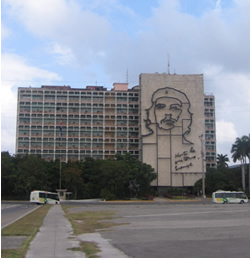 A day trip arranged through the travel operator would have cost 71 CUC per person, using Cubas overland coach company Viazul cost less than 20 CUC per person, go figure. Oh and CUCs? Thats the Peso Convertible, some sort of monopoly money Fidel and his buddies invented to get at foreign currency and not have tourists deal with the worthless regular Peso after the US Dollar was declared illegal a few years ago, following yet another ruckus with the big neighbour up north. As for Havana I cant really decide whether to loathe or love the place. The bits that have been restored and got a new slap of paint recently look absolutely gorgeous and overall you can get a good idea of the towns glorious heydays of the 30s and 40s when Hemingway hung out at his favorite bars and the jetset partied the nights away at the hotels. But the non-restored parts are so incredibly shoddy and nearly falling apart (well, some have fallen apart) that it’s simply heartbreaking to see a town gone to seed so much (and to think of people living in those ruins).
A day trip arranged through the travel operator would have cost 71 CUC per person, using Cubas overland coach company Viazul cost less than 20 CUC per person, go figure. Oh and CUCs? Thats the Peso Convertible, some sort of monopoly money Fidel and his buddies invented to get at foreign currency and not have tourists deal with the worthless regular Peso after the US Dollar was declared illegal a few years ago, following yet another ruckus with the big neighbour up north. As for Havana I cant really decide whether to loathe or love the place. The bits that have been restored and got a new slap of paint recently look absolutely gorgeous and overall you can get a good idea of the towns glorious heydays of the 30s and 40s when Hemingway hung out at his favorite bars and the jetset partied the nights away at the hotels. But the non-restored parts are so incredibly shoddy and nearly falling apart (well, some have fallen apart) that it’s simply heartbreaking to see a town gone to seed so much (and to think of people living in those ruins). A young guy had offered himself as a tourist guide to us, driving us the length of the famous Malecon, the seaside road, where the waves crash against the high embankment (and often soak those sitting there) and to the huge Plaza de la Revolucion where Fidel held his endless sermons in front of the crowd and which is now dominated by the spectacularly ugly liberty monument in honour of José Marti, the guy who first helped to drive the Spanish colonial rulers off Cuba (only to be replaced by the equally bloodsucking Americans) and a huge mural of Che Guevara on the façade of the Ministerio del Interio. And speaking of Che Guevara the guy is bloody well everywhere, on T-shirts, posters, postcards, walls and even beer mugs while Fidel or other revolutionaries are completely absent. A lesson for all you wannabe immortals out there: Make sure to die before the world finds out what a mess you got yourself into and leave a damn good-looking photo of yourself behind.
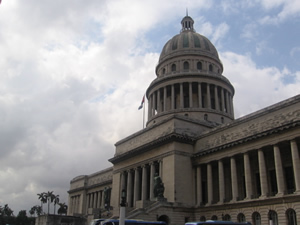 |
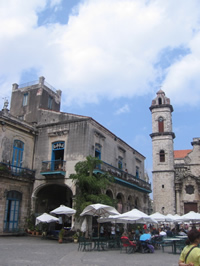 |
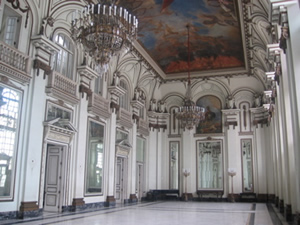 |
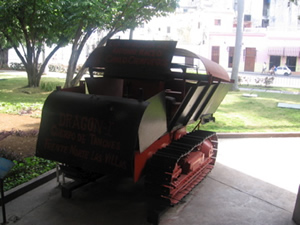 |
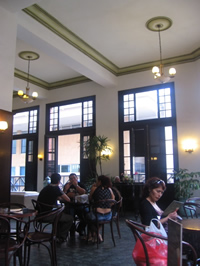 Finally we flopped under the arcades of the lovely art deco Hotel Inglaterra, where I I could also get internet access for the first and only time on Cuba (the hotel in Varadero did have internet computers, but the connection was down every time I checked). It was one of those grand old hotels that used to be the meeting place for foreigners, visitors and people with shady dealings in exotic locations and seemed straight out of a Graham Greene novel. I loved the place and sitting on its terrace, watching tourists and locals pass by on the street.
Finally we flopped under the arcades of the lovely art deco Hotel Inglaterra, where I I could also get internet access for the first and only time on Cuba (the hotel in Varadero did have internet computers, but the connection was down every time I checked). It was one of those grand old hotels that used to be the meeting place for foreigners, visitors and people with shady dealings in exotic locations and seemed straight out of a Graham Greene novel. I loved the place and sitting on its terrace, watching tourists and locals pass by on the street.On the way back to the port it began to drizzle (in the Caribbean!), so we ducked into the Hotel Ambos we just happened to pass on Havana's main shopping street, the Calle Obispo, one of Hemingways favorite watering holes, so we had a daiquiri there, before it was time to meet our guide from the morning again, who had promised to take us to the Viazul bus station on the outskirts of Havana. Of course by then the no extra charge, promise! had turned into 8 CUC, but a normal taxi would have cost the same I guess.
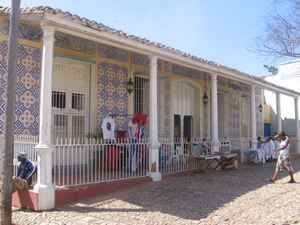 I had had the grand idea to do a tour across the island to get a better view at rural Cuba, too, but the taxi drivers all said that it was impossible to do Trinidad and Santa Clara on the same day after I saw the rural roads, I knew why. So we opted for picturesque Trinidad with its colonial center and gave Santa Clara with the Che Guevara memorial and his grave a miss (sorry Che). While Trinidad’s center was indeed very pretty, especially the Plaza Mejor, where you could almost see the colonial damsels strolling around in their crinoline skirts and lace umbrellas, accompanied by top-hatted caballeros, it was also one of those annoying tourist traps where you can hardly move without being accosted by someone trying to sell you cheap trinkets. On the way back we stopped in lovely Cienfuegos a town created by the insanely rich sugar mill owners of 19th century with a central avenue and a shady square with grand buildings, before going back to Varadero. While rural Cuba was certainly poor (in some villages we passed, people mostly used horse-drawn carts instead of cars), it was not worse off than other Caribbean countries let alone the shoddy mess that is rural India, and once more it was a good reminder of how over-saturated we here in the west are with all sorts of gadgets and junk.
I had had the grand idea to do a tour across the island to get a better view at rural Cuba, too, but the taxi drivers all said that it was impossible to do Trinidad and Santa Clara on the same day after I saw the rural roads, I knew why. So we opted for picturesque Trinidad with its colonial center and gave Santa Clara with the Che Guevara memorial and his grave a miss (sorry Che). While Trinidad’s center was indeed very pretty, especially the Plaza Mejor, where you could almost see the colonial damsels strolling around in their crinoline skirts and lace umbrellas, accompanied by top-hatted caballeros, it was also one of those annoying tourist traps where you can hardly move without being accosted by someone trying to sell you cheap trinkets. On the way back we stopped in lovely Cienfuegos a town created by the insanely rich sugar mill owners of 19th century with a central avenue and a shady square with grand buildings, before going back to Varadero. While rural Cuba was certainly poor (in some villages we passed, people mostly used horse-drawn carts instead of cars), it was not worse off than other Caribbean countries let alone the shoddy mess that is rural India, and once more it was a good reminder of how over-saturated we here in the west are with all sorts of gadgets and junk. 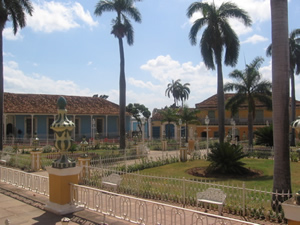 |
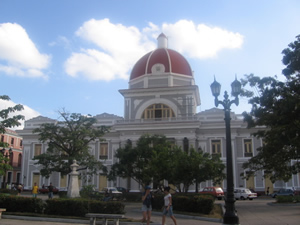 |
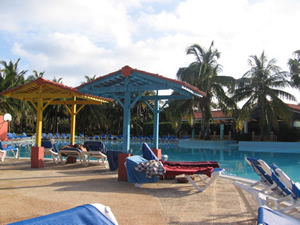 After these two trips the last day was once more spent on Varadero beach and at the hotel pool before it was time to stock up on Caribbean rum, souvenirs and go home. It was certainly a very interesting, thought-provoking trip (I dont think Ive ever had so many political discussions during a beach vacation!), but I still feel that I cant form any sort of judgement on Cuba or its socialismo. Sure, a lot there is bad, but there is so much wrong in our greedy consumerism society too, so I dont feel I have any right to be opinionated. I just hope for the sake of the charming friendly Cubans, who were incredibly nice to us everywhere, that they will be able to enjoy more freedom while still retain their independence from the big neighbour in the north.
After these two trips the last day was once more spent on Varadero beach and at the hotel pool before it was time to stock up on Caribbean rum, souvenirs and go home. It was certainly a very interesting, thought-provoking trip (I dont think Ive ever had so many political discussions during a beach vacation!), but I still feel that I cant form any sort of judgement on Cuba or its socialismo. Sure, a lot there is bad, but there is so much wrong in our greedy consumerism society too, so I dont feel I have any right to be opinionated. I just hope for the sake of the charming friendly Cubans, who were incredibly nice to us everywhere, that they will be able to enjoy more freedom while still retain their independence from the big neighbour in the north.
Copyright © All Rights Reserved